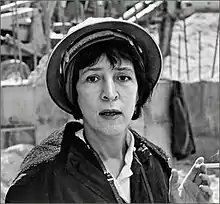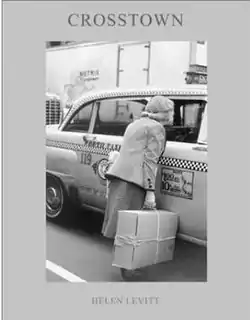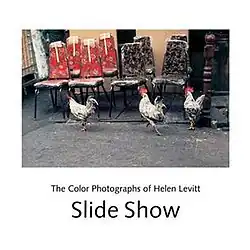Helen Levitt | |
|---|---|
 1963 | |
| Born | August 31, 1913 Brooklyn, New York, U.S. |
| Died | March 29, 2009 (aged 95) New York City, U.S. |
| Known for | Photography |


Helen Levitt (August 31, 1913 – March 29, 2009)[1][2] was an American photographer and cinematographer. She was particularly noted for her street photography around New York City. David Levi Strauss described her as "the most celebrated and least known photographer of her time."[3]
A retrospective exhibition of Levitt's work, In the Street, was shown at The Photographers' Gallery in London from October 2021 to February 2022.[4]
Early life and education
Levitt was born in Bensonhurst, Brooklyn, New York, the daughter of May (Kane), and Sam Levitt.[5] Her father and maternal grandparents were Russian Jewish immigrants.[6] She went to New Utrecht High School but dropped out in 1931.[7]
Work in photography
She began photography when she was eighteen[8] and in 1931 she learned how to develop photos in the darkroom when she began working for J. Florian Mitchell, a commercial portrait photographer in the Bronx.[9][10] She also attended many classes and events hosted by the Manhattan Film and Photography League.[8] This was also around the time she was exposed to the work of Henri Cartier-Bresson at the Julien Levy Gallery,[11][12] who she was also able to meet through the league.[8] His work became a major influence for her photography as it inspired her to change from her more journalistic and commercial approach to photography to a more personal one.[13]
In 1936, she purchased a Leica camera (a 35 mm range-finder camera).[14] While teaching art classes to children in 1937 for New York City's Federal Art Project,[15] Levitt became intrigued with the transitory chalk drawings that were part of the New York children's street culture of the time.[16][17] She began to photograph these chalk drawings, as well as the children who made them for her own creative assignment with the Federal Art Project. They were ultimately published in 1987 as In The Street: chalk drawings and messages, New York City 1938–1948.[8][18]
She continued taking more street photographs mainly in East Harlem but also in the Garment District and on the Lower East Side, all in Manhattan.[19] During the 1930s to 1940s, the lack of air conditioning meant people were outside more, which invested her in street photography.[20] Her work was first published in Fortune magazine's July 1939 issue.[21] The new photography section of the Museum of Modern Art, New York included Levitt's work in its inaugural exhibition in July 1939.[22] In 1941, she visited Mexico City with the then wife of author James Agee and took photos of the area.[23] In 1943, Nancy Newhall curated her first solo exhibition Helen Levitt: Photographs of Children.[24]
In 1959 and 1960, she received two grants from the Guggenheim Foundation for her pioneering work in color photography.[25] In 1965 she published her first major collection, A Way of Seeing.[26] Much of her work in color from 1959 to 1960 was stolen in a 1970 burglary of her East 12th Street apartment. The remaining photos, and others taken in the following years, can be seen in the 2005 book Slide Show: The Color Photographs of Helen Levitt.[27] A second solo exhibit, Projects: Helen Levitt in Color, was held at the Museum of Modern Art, New York in 1974.[28] Her next major shows were in the 1960s; Amanda Hopkinson suggests that this second wave of recognition was related to the feminist rediscovery of women's creative achievements.[22] In 1976, she was a Photography Fellow of the National Endowment for the Arts.[29]
Levitt lived in New York City and remained active as a photographer for nearly 70 years. However, she expressed lament at the change of New York City scenery:
"I go where there's a lot of activity. Children used to be outside. Now the streets are empty. People are indoors looking at television or something."[25]
Work in film making
In the late 1940s, Levitt made two documentary films with Janice Loeb and James Agee: In the Street (1948) and The Quiet One (1948). Levitt, along with Loeb and Sidney Meyers, received an Academy Award nomination for The Quiet One.[30] Levitt was active in film making for nearly 25 years; her final film credit is as an editor for John Cohen's documentary The End of an Old Song (1972).[31] Levitt's other film credits include the cinematography on The Savage Eye (1960),[32] which was produced by Ben Maddow, Meyers, and Joseph Strick, and also as an assistant director for Strick and Maddow's film version of Genet's play The Balcony (1963). In her 1991 biographical essay, Maria Hambourg wrote that Levitt "has all but disinherited this part of her work."[18] In 2012 Deane Williams published a comprehensive overview of Levitt's films in Senses of Cinema.[33]
Style and themes
Helen Levitt was most well known and celebrated for her work taking pictures of children playing in the streets. She also focused her work in areas of Harlem and the Lower East side with minority populations.[34] There is a constant motif of children playing games in her work.[35] She stepped away from the normal practice set by other established photographers at the time of giving a journalistic depiction of suffering. She instead chose to show the world from the perspective of children from taking pictures of their chalk art. She usually positions the camera and styles the photo in a way that gives the focus of her photography power.[36]
Her choice to display children playing in the street and explore street photography, fights against what was going on at the time. Legislation being passed in New York at the time was limiting many of the working classes access to these public spaces. Laws were passed that directly targeted these communities in an attempt to control them. New bans on noise targeted working class and minority communities.[36] There was a movement to also try to keep children from playing on the street, believing it is unsafe for them out there. Instead, it encouraged safe new areas that were usually built more in upper and middle class areas. Helen Levitt instead explored the narrative of those who lived in these areas and played in these streets as a way to empower the subjects of her photos.[36]
Personal life and death
She had to give up making her own prints in the 1990s due to sciatica, which also made standing and carrying her Leica difficult, causing her to switch to a small, automatic Contax.[37] She was born with Ménière's syndrome, an inner-ear disorder that caused her to "[feel] wobbly all [her] life." She also had a near-fatal case of pneumonia in the 1950s.[1] Levitt lived a personal and quiet life. She seldom gave interviews and was generally very introverted. She never married, living alone with her yellow tabby Blinky.[20] Levitt died in her sleep on March 29, 2009, at the age of 95.[1]
Exhibitions
Solo exhibitions
- Helen Levitt: Photographs of Children, Museum of Modern Art, New York, 1943. Curated by Nancy Newhall.
- Projects: Helen Levitt in Color, Museum of Modern Art, New York, 1974.[28]
- Street Portrait: The Photographs of Helen Levitt Museum of Fine Arts, Boston, 1983[38]
- Moderna Museet, Stockholm, 1985. A retrospective.
- The Photographers' Gallery, London, 1988. A retrospective.
- San Francisco Museum of Modern Art, 1991 then toured nationally 1991–1993. A retrospective.[39]
- Diputación Provincial de Granada, Spain, 1994 and toured. A retrospective.
- International Center of Photography, New York, 1997. A retrospective.[40]
- Centre national de la photographie, Paris, 2001. A retrospective.
- Henri Cartier-Bresson Foundation, Paris, 2007. A retrospective.
- Foam Fotografiemuseum Amsterdam, 2008. A retrospective.
- Sprengel Museum, Hannover, 2008 (accompanied her award for the Spectrum International Photography Prize). A retrospective.
- PHotoEspaña, Madrid, 2010 and toured. A retrospective.
- Albertina Museum, Vienna, 2018. A retrospective.
- In the Street, The Photographers' Gallery, London, 2021/22. A retrospective.[4][41]
Group exhibitions
- Museum of Modern Art, New York, 1939[22]
- Fondation Henri Cartier-Bresson, Paris, 2023. Henri Cartier-Bresson, Helen Levitt - Mexico.
Publications
- Levitt, Helen; Agee, James (1989) [1965]. A Way of Seeing: Third Edition. Duke University Press. ISBN 978-0-8223-1005-1.
- Levitt, Helen; Coles, Robert (1987). In the Street: Chalk Drawings and Messages, New York City, 1938-1948. Duke University Press. ISBN 0-8223-0771-5.
- Levitt, Helen; Hambourg, Maria Morris; Phillips, Sandra S. (1991). Phillips, Sandra S. (ed.). Helen Levitt. San Francisco Museum of Modern Art. ISBN 0-918471-22-2.
- Levitt, Helen; Oles, James (1997). Helen Levitt: Mexico City. W. W. Norton & Company. ISBN 0-393-04549-8.
- Levitt, Helen; Prose, Francine (2001). Crosstown. powerHouse Books. ISBN 1-57687-103-7.
- Levitt, Helen; Gopnik, Adam (2004). Here and There. powerHouse Books. ISBN 1-57687-165-7.
- Levitt, Helen; Szarkowski, John (2005). Slide Show: The Color Photographs of Helen Levitt. powerHouse Books. ISBN 978-1-57687-252-9.
- Levitt, Helen; Evans, Walker (2008). Helen Levitt. powerHouse Books. ISBN 978-1-57687-429-5.
- Levitt, Helen; Trachtenberg, Alan; Chevrier, Jean-François; Ribalta, Jorge (2010). Helen Levitt: Lírica Urbana. La Fabrica Editorial. ISBN 978-84-92841-24-0.
- Levitt, Helen (2017). One, two, three, more. Introduction by Geoff Dyer. Brooklyn: PowerHouse.
- Levitt, Helen (2017). Manhattan Transit: The Subway Photographs of Helen Levitt. Introduction by David Campany. Galerie Thomas Zander and Verlag der Buchhandlung Walther König. ISBN 978-3-96098-122-0.
Films
- In the Street (1948): cinematographer and editor
- The Quiet One (1948): cinematographer and writer
- The Stairs (1950): producer
- The Savage Eye (1960): cinematographer
- The Balcony (1963): assistant director
- An Affair of the Skin (1963): co-producer with Ben Maddow
- In the Year of the Pig (1968): co-editor with Hannah Moreinis[42]
- The End of an Old Song (1972): editor
Awards
- 2008: Francis J. Greenburger Award for excellence in the arts[43]
References
- 1 2 3 Loke, Margaret (March 30, 2009). "Helen Levitt, Who Froze New York Street Life on Film, Is Dead at 95". The New York Times. Archived from the original on April 16, 2009. Retrieved March 30, 2009.
- ↑ Rourke, Mary (April 1, 2009). "Helen Levitt dies at 95; New York street photographer of poignant dramas". Los Angeles Times. Archived from the original on April 3, 2009. Retrieved April 1, 2009.
- ↑ O'Hagan, Sean (October 2, 2021). "Helen Levitt: the most celebrated, least known photographer of her time". The Guardian. Archived from the original on December 3, 2021. Retrieved December 4, 2021.
- 1 2 "Meet the real Helen Levitt, New York's most intimate chronicler". The Guardian. 2 October 2021. Archived from the original on 2021-10-16. Retrieved 2021-10-16.
- ↑ Loke, Margarett (2009-03-30). "Helen Levitt, Who Froze New York Street Life on Film, Is Dead at 95". The New York Times. ISSN 0362-4331. Archived from the original on 2021-12-04. Retrieved 2021-12-04.
- ↑ "Helen Levitt". Family Search. The Church of Jesus Christ of Latter-day Saints. Archived from the original on 2021-12-05. Retrieved 2020-04-04.
- ↑ Grand, Elizabeth (2009). "Helen Levitt (1913–2009) and the Camera". American Art. 23 (3): 98–102. doi:10.1086/649790. S2CID 192186702. Archived from the original on 2021-12-04. Retrieved 2021-12-04 – via University of Chicago Press Journals.
- 1 2 3 4 Graves, Lauren (2021). "Inheritors of the Street: Helen Levitt Photographs Children's Chalk Drawings". Buildings & Landscapes: Journal of the Vernacular Architecture Forum. 28 (1): 58–83. doi:10.5749/buildland.28.1.0058. ISSN 1936-0886. JSTOR 10.5749/buildland.28.1.0058. S2CID 238008765. Archived from the original on 2021-12-04. Retrieved 2021-12-04.
- ↑ "Levitt, Helen (1913–) | Encyclopedia.com". www.encyclopedia.com. Archived from the original on 2021-03-29. Retrieved 2019-07-05.
- ↑ "The Economist". Economist Newspaper Limited. July 5, 2009. Archived from the original on December 5, 2021. Retrieved July 24, 2021 – via Google Books.
- ↑ "Helen Levitt". April 23, 2009. Archived from the original on March 4, 2018. Retrieved April 2, 2018 – via www.telegraph.co.uk.
- ↑ "Helen Levitt". Smithsonian American Art Museum. Archived from the original on 2021-03-22. Retrieved 2019-07-05.
- ↑ "Museum of Contemporary Photography". www.mocp.org. Archived from the original on 2021-12-04. Retrieved 2021-12-04.
- ↑ Peres, Michael R. (May 29, 2013). The Focal Encyclopedia of Photography. Taylor & Francis. ISBN 9781136106132. Archived from the original on December 5, 2021. Retrieved July 24, 2021 – via Google Books.
- ↑ Graves (2021). "Inheritors of the Street: Helen Levitt Photographs Children's Chalk Drawings". Buildings & Landscapes: Journal of the Vernacular Architecture Forum. 28 (1): 58. doi:10.5749/buildland.28.1.0058. ISSN 1936-0886. S2CID 238008765.
- ↑ "Graffiti: Chalk Drawing of Figure with Double Pupils, New York City (ca. 1940)". Metropolitan Museum of Art. Archived from the original on 2021-03-22. Retrieved 2019-07-05.
- ↑ "Museum of Contemporary Photography". www.mocp.org. Archived from the original on 2021-03-22. Retrieved 2019-07-05.
- 1 2 Hambourg, Maria Morris (1991). "Helen Levitt: A Life in Part". In Phillips, Sandra S. (ed.). Helen Levitt. San Francisco Museum of Modern Art. pp. 45–63. ISBN 0-918471-22-2.
- ↑ Silverman, Rena (January 16, 2019). "Helen Levitt's Street Photos Blend the Poetic With the Political". The New York Times. Archived from the original on March 22, 2021. Retrieved July 5, 2019.
- 1 2 "Helen Levitt". The Telegraph. 23 April 2009. Archived from the original on 17 March 2017. Retrieved March 11, 2017.
- ↑ Gand, Elizabeth (September 1, 2009). "Helen Levitt (1913–2009) and the Camera". American Art. 23 (3): 98–102. doi:10.1086/649790. S2CID 192186702.
- 1 2 3 Hopkinson, Amanda (April 3, 2009). "Obituary - Helen Levitt: Award-winning New York photographer noted for street scenes and social realism". The Guardian. Archived from the original on March 12, 2017. Retrieved December 11, 2016.
- ↑ "Museum of Contemporary Photography". www.mocp.org. Archived from the original on 2021-12-04. Retrieved 2021-12-05.
- ↑ "Helen Levitt". International Center of Photography. 2018-01-31. Archived from the original on 2021-03-22. Retrieved 2021-12-05.
- 1 2 Loke, Margarett (2009-03-30). "Helen Levitt, Who Captured New York Street Life, Dies at 95". The New York Times. ISSN 0362-4331. Archived from the original on 2017-03-13. Retrieved 2017-03-11.
- ↑ Levitt, Helen (1989). A Way of Seeing: Third Edition. Duke University Press. ISBN 978-0-8223-1005-1.
- ↑ Levitt, Helen (2005). Slide Show: The Color Photographs of Helen Levitt. powerHouse Books. ISBN 978-1-57687-252-9.
- 1 2 "Projects: Helen Levitt in Color". Archived from the original on 2021-03-22. Retrieved 2020-03-14.
- ↑ "Helen Levitt". International Center of Photography. 2017-02-04. Archived from the original on 2021-03-22. Retrieved 2017-03-11.
- ↑ "The 21st Academy Awards | 1949". Oscars.org | Academy of Motion Picture Arts and Sciences. Archived from the original on 2011-07-06. Retrieved 2021-12-05.
- ↑ Mathews, Scott (2008-08-06). "John Cohen in Eastern Kentucky: Documentary Expression and the Image of Roscoe Halcomb During the Folk Revival". Southern Spaces. Archived from the original on 2012-10-25. Retrieved 2010-08-12.
- ↑ Jackson, Benjamin T. (Summer 1960). "The Savage Eye". Film Quarterly. 13 (4): 53–57. doi:10.1525/fq.1960.13.4.04a00160.
- ↑ Williams, Deane (March 2012). "Helen Levitt". Senses of Cinema (62). Archived from the original on 2016-05-25. Retrieved 2016-06-18. A critical review of Levitt's filmmaking career.
- ↑ Rourke, Mary (April 1, 2009). "Helen Levitt dies at 95; New York street photographer of poignant dramas". Los Angeles Times. Archived from the original on December 4, 2021. Retrieved December 4, 2021.
- ↑ Elizabeth, Gand. "Helen Levitt (1913-2009) and the Camera". American Art. 23: 98–102 – via EBSCO HOST.
- 1 2 3 Graves (2021). "Inheritors of the Street: Helen Levitt Photographs Children's Chalk Drawings". Buildings & Landscapes: Journal of the Vernacular Architecture Forum. 28 (1): 58. doi:10.5749/buildland.28.1.0058. ISSN 1936-0886. S2CID 238008765. Archived from the original on 2021-12-31. Retrieved 2021-12-04.
- ↑ "Helen Levitt". The Economist. 2009-04-08. ISSN 0013-0613. Archived from the original on 2021-12-05. Retrieved 2021-12-05.
- ↑ Foresta, Merry A. (July 5, 1984). "Exposed and Developed: Photography Sponsored by the National Endowment for the Arts". National Museum of American Art. Archived from the original on December 5, 2021. Retrieved July 24, 2021 – via Google Books.
- ↑ Kort, Carol; Sonneborn, Liz (May 14, 2014). A to Z of American Women in the Visual Arts. Infobase Publishing. ISBN 9781438107912. Archived from the original on December 5, 2021. Retrieved July 24, 2021 – via Google Books.
- ↑ Strauss, David Levi (October 1997). "Helen Levitt: International Center for Photography - exhibition". Artforum. Archived from the original on 2020-06-11. Retrieved 2008-08-11.
- ↑ Diggins, Alex (13 October 2021). "Helen Levitt: In the Street, review: the marvellous, off-kilter world of New York City's streets". The Telegraph. ISSN 0307-1235. Archived from the original on 2021-10-15. Retrieved 2021-10-16.
- ↑ Barsam, Richard Meran (1992). Nonfiction Film: A Critical History. Indiana University Press. p. 418. ISBN 978-0-253-20706-7.
- ↑ "Helen Levitt" (PDF). Jackson Fine Art. Archived (PDF) from the original on April 29, 2017. Retrieved March 11, 2017.
Further reading
- Block, Melissa (January 17, 2002). "Helen Levitt's Indelible Eye". All Things Considered. National Public Radio. Radio program featuring an interview with Levitt.
- Dikant, Thomas (2003). "Helen Levitt: 10 Photographs". Philologie in Netz. 25: 1–30. Archived from the original on 2009-03-17. Critical study of ten of Levitt's photographs. Dikant also discusses the influences on Levitt, including Henri Cartier-Bresson, Ben Shahn, and Walker Evans.
- Williamson, Marcus (April 17, 2009). "Helen Levitt: Photographer renowned for her portraits of street life in New York". The Independent.
- Smith, Joel (February 22, 2018). "People watching". The New York Review of Books. 65 (3): 22–24. Reviews One, two, three, more.
External links
![]() Media related to Helen Levitt at Wikimedia Commons
Media related to Helen Levitt at Wikimedia Commons
- Helen Levitt: New York Streets 1938 to 1990s at LensCulture
- Helen Levitt at IMDb. Note that there is occasionally confusion of Levitt's film credits with those of Helen Slote Levitt.